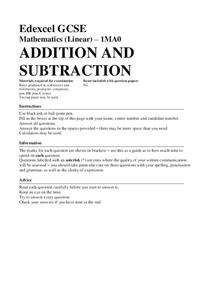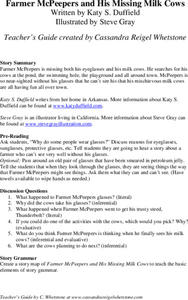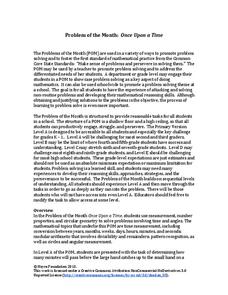Mathed Up!
Addition and Subtraction
After watching a brief video on addition and subtraction, young mathematicians are put to the test. Including 12 problems, individuals solve word problems to find the least number, total amount, and difference of numbers.
Illustrative Mathematics
Counting Squares
Challenge young mathematicians' understanding of squares with this geometry puzzle. The task is simple, identify as many squares as possible in a 3x3 array. Allow learners to work independently or in pairs as they search for squares,...
K20 LEARN
Building To 100: Building And Decomposing Numbers
Following a catchy video about decomposing numbers, young mathematicians build and write numbers using dice. Class members work to create an anchor chart that displays six ways to make numbers. Beans get scooped and estimated, then...
K12 Reader
Conjunctions: And
Math isn't the only subject where pupils get to add! Focus on conjunctions with a grammar lesson in which class members connect nouns with the word and.
K20 LEARN
Building Numbers: Addition And Subtraction Up To 10
Animals on Board! Stuart J. Murphy introduces scholars to composed numbers in preparation for writing and drawing true or false number sentences. A game of Bear in the Cave challenges pupils to locate a missing addend. Sorting...
Cassandra Reigel Whetstone
Farmer McPeepers and His Missing Milk Cows
Pair your reading of Farmer McPeepers and His Missing Milk Cows with the questions and activities provided here. Learners answer questions about the text, create story maps, put together brochures, relate math to the story, practice...
Curated OER
Logic- Always and Sometimes
Second graders investigate logical reasoning. In this math vocabulary instructional activity, 2nd graders explore the words: always and sometimes while evaluating story problems. Students create images on KidPix to illustrate their...
Curated OER
Make the Correct Times On Each Clock
Nine blank clocks are awaiting to receive their hands on this time-telling worksheet. Students are given a time, which they must correctly represent on each clock. This would be a great assessment worksheet.
Garden of Praise
George Washington Carver Test
This is a standard multiple-choice assessment on the life and ideas of George Washington Carver. It includes 20 questions on topics covering information about his birth and education, major career moves, teaching principles, ethics, etc.
Illustrative Mathematics
Party Favors
Pia is putting stickers into party bags. She starts by putting 10 stickers in each bag, and over the course of a week she adds several bundles of ten stickers to each bag, as well as making more bags. Second graders must find the number...
American Farm Bureau Foundation for Agriculture
Shapes on the Farm
Whether you live in the city, the suburbs, or out on the farm, shapes are everywhere in the world around us. Presented with an illustration of a farm, youngsters are tasked with coloring in all of the triangles,...
Noyce Foundation
Once Upon a Time
Examine the relationship between time and geometry. A series of five lessons provides a grade-appropriate problem from elementary through high school. Each problem asks learners to compare the movement of the hands on a clock to an angle...
Noyce Foundation
Movin 'n Groovin
Examine the consequences of varying speed. An engaging set of five problem sets challenges young mathematicians by targeting a different grade level from K-12. In the initial lesson, scholars make conclusions about the time it...
Math in English
3-D Shapes
Young mathematicians look at five 3-D shapes and name them based on the accompanying image. For each shape, learners state the number of faces, vertices, and edges.
Illustrative Mathematics
Find the Missing Number
First graders are asked to find the missing numbers in subtraction and addition equations. Each missing number is represented with a box and appears as an addend, subtrahend, sum, or difference.
Illustrative Mathematics
Valid Equalities?
True or false: 20 = 10 + 10. The statement is true because two 10s make a 20. These are the types of equations learners must label or false. They must also explain in mathematical terms how they know.
Illustrative Mathematics
Maria’s Marbles
Ali has more marbles than Maria in some of these word problems, while in others Maria has more marbles than Ali. First graders are tasked to read each word problem and solve how many marbles each girl has.
Illustrative Mathematics
Daisies in Vases
Have your first graders master word problems with an activity that prompts them to find as many combinations for daisies in vases, with the most in the large vase and the least in the small vase. Pupils must also explain their...
Illustrative Mathematics
Ordering Time
Practice telling time to the nearest five minutes in a digital and analog clock activity. Learners are prompted to order clock cards in increasing time order, and then write the time each clock represents.
Illustrative Mathematics
Regrouping
What number does 6 tens and 16 ones represent? How is it different from or similar to the number that 7 tens and 6 ones represent? This is the type of questions learners are asked to solve as a way to understand the concept of regrouping.
Illustrative Mathematics
Comparisons 2
Need a quick review for greater than or less than? Young mathematicians use <, >, or = to complete a set of seven comparison number sentences.
Curated OER
Buggin' Out (Identifying and Adding Amounts of Money)
Learners explore consumer math by participating in estimate exercises. In this currency lesson, students identify and define each piece of U.S. currency and their value to the monetary system. Learners complete several money worksheets...
Curated OER
Where are you Spider?
First graders investigate the proximity of objects in space. In this proximity lesson, 1st graders place a felt spider in different locations on a teacher made book, and they describe its proximity to certain items in that book. Students...
Curated OER
It's About Time!
Students read a short tutorial and complete one or more online activities. They visit an online math dictionary to learn the value of a day, month, week, and year. In addition, they construct word problems based on a favorite month;...
Other popular searches
- Math Assessment on Coins
- Elementary Math Assessments
- Math Assessment Test
- Math Assessment Fractions
- Cumulative Math Assessment
- Fitness Assessment Math
- Baseline Math Assessment
- Third Grade Math Assessment
- First Grade Math Assessment
- Grade 4 Math Assessment
- Math Assessment Questions
- Basic Math Assessment























